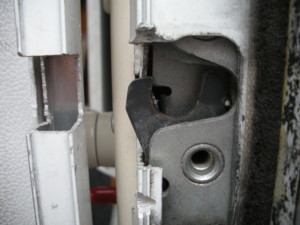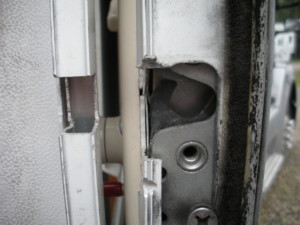Have you ever noticed that most door latches on RV doors, especially on trailers and compartment doors, resemble a residential door latch more so that what’s on a car? It’s really a significant safety problem—in terms of somebody or something falling out, or somebody unwanted gaining access. On the maiden voyage in my current motorhome, on some rough midwestern pavement, the main entry door did in fact pop open. Fortunately, my RV was relatively empty, and the two passengers with me weren’t near the door.
The latch bolt—that’s the spring-loaded tapered piece that holds the door shut—relies on a close fit between the door and door frame to stay latched. That’s fine in a normal house, where that gap can be adjusted and generally doesn’t move. But in an RV that bounces and flexes all the time, that gap can open up, and the bolt can be jarred (it’s just a spring keeping it extended) to the point that the latch comes free and the door opens. It’s not just the entry door that matters. Think about the storage bays filled to the brim, and what might fall out if one opened.
FMVSS 206
So why is an automotive-style door latch better? First of all, they’re designed to meet a performance standard in Federal Motor Vehicle Safety Standards for door latches (FMVSS 206). Technically, it applies to the whole door, including hinges, but there are a few basic designs that cover almost all applications for hinged doors. If you look at a normal car door latch (a primary door latch), there are two retention positions—a fully-closed position and a secondary position. The fully-closed position has to withstand 9000N (2,023 pounds force) in one direction, and 11,000N (2,473 pounds force) in the other. The secondary position has to be able to withstand 4,500N in both directions. The latch also has to be able to survive a 30 G inertial loading as well—that’d easily knock a normal latch bolt loose. A deadbolt won’t be as susceptible to an inertial load, but it’s still going to fail if the door and door frame separate far enough. Your car door’s latch will likely still be holding even after you’ve mangled the door and door pillar.
The way most designs meet these requirements is with a “bear claw” style latch. There are two jaws that close around a striker bolt or hasp. When closed, niether sliding the latch along the bolt (as in trying to pry the door frame and door away from each other) nor pulling against the jaw ends (as in trying to pry the door open) will allow the latch to let go. The secondary closed position is where the jaws aren’t fully closed, but still won’t allow the striker bolt to come free. That’s the position you’re familiar with when you’ve locked the door and don’t slam it shut hard enough—it’s closed enough that you can’t open it back up and try again, but open enough that the dome light is still on.
Does FMVSS 206 apply to all of my baggage doors or to a travel-trailer or fifth-wheel? Not really. It applies to vehicles, not including trailers, with a Gross Vehicle Weight Rating (GVWR) less than 10,000 lbs. It’s also a standard designed for occupant protection, so luggage compartments aren’t regulated either. Granted, we’re not all that worried about everything staying put in an accident like we would be in a car, but we also don’t want to be losing stuff along the highway, where it could cause damage or cause someone else to have an accident.
Latch with Pins
The latch I had was the one pictured above. There’s an in-between style, pictured below, that was probably most popularly made by Bargman.

It’s a significant step above the first latch, in that it has a set of pins that engage the striker plate to hold it close to the latch bolt. But there’s no partially closed position, and in my experience (I had this type of latch on my first motorhome) the pins tend to loosen over time and are missing in many cases. So if you have this style of latch, check the pins regularly.
Bear Claw Latch
Then there’s an automotive-style latch that can be installed as part of an FMVSS 206-compliant door system:

If you visit Trimark’s website, you’ll see the following text:
Meets FMVSS 206 load requirements and may be used in FMVSS 206 applications pending TriMark application approval.
Notice that it doesn’t say DOT approved or certified (that language will be the subject of a future post), but that it can meet FMVSS206 requirements. If we take a closer look, we can see each of the three positions:



The bottom line is that the mechanism for holding the door closed is much more secure.
Of course, if you have one of the usual RV-style locks, latching and staying closed during travel is only one part of the problem. Many are keyed alike—the CH751 key is well known to be everywhere. But even other lock styles–from FIC, Global, Trimark, etc.–are generally made with the same key unless the manufacturer specifies one of several dozen optional key codes.
In Part 2 of this article we will show you the process of upgrading an entry door latch. Until next time.
–Dave
Can you please let me know when Part 2, Upgrading an RV door latch? Thank you!
Absolutely! And you’ve just poked me to remind me I hadn’t written it yet!